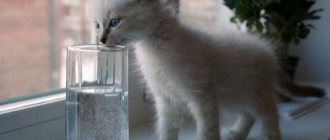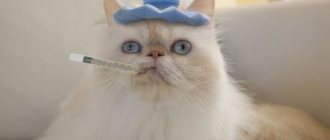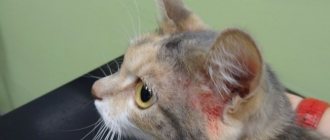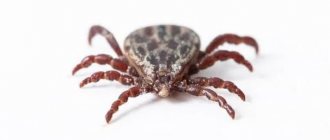An overly hyperactive kitten can be difficult to deal with, especially since the average kitten is already a ball of fluffy energy that is difficult to control and train. But it's also important to remember that it's completely normal for kittens to have a lot of energy and want to run, climb, jump, chase and play. In fact, if your kitty isn't acting this way, consider talking to your veterinarian to make sure your little fur baby is doing well.
If your kitten seems to have endless energy and you want to help him relax a little, there are ways to calm a hyperactive kitten. Most solutions involve simply providing your pet with different ways to release his energy in a positive way. This way she will be ready to rest and recharge. So, before you lose patience with your rambunctious little friend, keep reading for some tips. And if you've tried several different strategies but nothing has worked, and you think your kitten is oversensitive, consult your veterinarian for support and guidance.
Give your kitten her own sanctuary
If your kitten is acting up, let him relax in his own sanctuary. This could be a dimly lit, small room where he can relax away from other pets, distractions and people. It should also be a space where the kitten can play and release his energy without worrying about destroying anything.
© shutterstock
Like all other rooms in your home where your kitten will spend time, it should be a safe place where he will not be at risk of harm. So take the time to make sure there are no places where your kitten could accidentally get stuck (this may require blocking off part of the room so the kitten can't walk through and get hurt). It's also a good idea to remove valuables or items that could be broken by a cheerful kitten who sees almost anything as a potential toy. And make sure there are no small objects that could be dangerous to your pet or objects that could be accidentally swallowed.
With a safe space filled with cat toys, scratching posts, a cat tree, a litter box, food and water, your kitty will be ready to explore, play and practice becoming the natural predator that she is.
Just a stage
Your new kitten is exhibiting completely normal behavior. He grows quickly, eats a lot and has so much energy that he doesn't know what to do with it. When he runs around like crazy, chasing everything, it's completely normal. If you happen to see a weird or unnatural expression on his face, yes, it's crazy, but it's normal for kittens. Each cat is different, but as a rule, hyperactivity decreases markedly after sterilization. Your veterinarian may recommend that your pet be spayed before 6 months of age. You'll also likely notice in the weeks leading up to his first birthday that he'll increasingly gravitate towards you and just want to cuddle.
Play soothing music
Often, kittens may behave hyperactively as a result of uncertainty or fear, which may be caused by being in a new home, sharing that new home with strange new cats and people, or other stimulants in the environment.
Once you've given your kitten a safe place, try playing music at a low volume. Choose soft music, instrumental or classical music, as it will calm your kitty's nerves just as music calms yours.
How to calm a hyperactive cat?
Despite the time of coexistence between humans and cats, we are still surprised by aspects of their behavior. Therefore, in this article we will focus on how to recognize and calm a hyperactive cat.
We will first define the behavior we will address and then explain what guidelines we can follow to help and understand our cat, and above all we will differentiate normal behavior in a healthy cat from what may require consultation with a professional. Discover below how to calm a hyperactive cat, as well as other top tips for your well-being:
Play properly
Kittens need play time to develop. They absolutely need to be able to release their energy in a fun and positive way, and will use every play session as an opportunity to practice their hunting skills. Plus, play is a great form of exercise, and as your kitten grows and becomes more coordinated, she'll want to practice using her new abilities to climb, jump, chase, and explore. You can give your kitten time to play on his own, but spending time with your pet every day will also help him release more energy and avoid boredom and loneliness.
Having multiple play sessions with your hyperactive kitten throughout the day is a great way to bond with him while helping him release excess energy. The games you play should simulate hunting, so use toys such as sticks with feathers on the end or stuffed mice that will attract your kitten's attention and inspire his natural predatory skills. Challenge your kitten during play, but also let her win so she experiences the thrill of destroying her prey, even if it's only in her imagination.
How to reduce activity?
To calm a small cat that is more than a month old, you should provide it with a variety of toys. Hanging mice, birds, and balls are suitable, which the baby can catch and run after. Such fun should not have sharp elements, the elastic bands are soft, without feathers that the cat can bite off and swallow. Playful kittens should be provided with a high scratching post with holes for climbing. It is advisable for the owner to play with the cat more often, since a running baby quickly runs out of energy and falls asleep.
The owner's gentle stroking will help the baby calm down.
If the baby has become overly excited due to a stressful situation, the owner’s gentle voice and calm stroking will help reduce the tension. Sedatives that are given to the kitten after consultation with a veterinarian are effective. It is important to adjust your diet. The baby should eat high-quality industrial food suitable for age. This diet provides a daily dose of essential microelements. Your doctor will recommend additional vitamin supplements.
If a kitten constantly runs around due to a disruption of the endocrine system, the veterinarian prescribes therapy individually. Sometimes it is necessary to have surgery for excessive growth of thyroid tissue or give your pet medications to normalize hormone levels. Hills Y/D Thyroid Health has released a special dietary dry food for cats suffering from hyperthyroidism. Medical attention is also needed if a hyperactive kitten, who was previously in motion all day, has stopped running and lies down all the time.
Source
Let your kitten roam safely in nature
If you think your kitten is hyperactive because he has a lot of energy and is tired of being indoors, letting him explore nature in your own backyard for a while may be just what he needs.
Whether you're building or buying an outdoor enclosure or purchasing a large outdoor cat enclosure, you can sit outside with your kitty while she enjoys the fresh air and sun, watches birds and insects, and finds new and exciting ways to release her energy.
© shutterstock
Cat activity
First of all, it is important to know what the habitual behavior of cats is in order to know in what cases their activity can be understood as pathological, and vice versa. To do this, it is important to know that the cat's activities will be related to their age.
This way, as a kitten, it will be easy to watch him play with any object that can be caught, bitten, or beaten. It is not strange for them to run or jump at high speeds, climb to significant heights, or even climb walls. This intense activity is completely normal in a kitten and is a sign of health. It is at this stage that we must lay the foundations of "safe" play, i.e., distract their attention if they intend to play and bite their fingers or catch their foot. It is worth offering an adequate range of toys.
No need to buy complex mechanisms. An aluminum foil ball or wall lantern can provide hours of entertainment. In addition, it is very important to offer a safe environment, given his taste for heights and his ability to hide in the most unexpected and secretive places. Therefore, we must examine our home with "cat's eyes" to eliminate or reduce any danger, for example by using mosquito nets for windows and balconies.
Once the first years of life are over, we will notice that a large number of cats have unbridled activity and hours of play decrease, although this aspect will also depend on the nature of the cat, which will be more or less playful and active.
They usually run away, running in a direction that only they know. After a few minutes of crazy racing, they return to a state of calm, as if nothing had happened. This situation is completely normal and does not cause any cause for alarm due to hyperactivity, so activity, although high, is also not a cause for concern in kittens.
Try puzzle toys
Puzzle toys are a great way for kittens to get exercise, but they will also get a mental workout. With these toys, you can strategically hide treats so your pet will have to work a little to figure out how to get to them. Additionally, this type of toy can attract the attention of your hyperactive kitty, and once he smells the treats inside, he will need to use his energy to solve the mystery and get to those tasty treats.
There are many different puzzle toys to choose from, so you can find several that are sure to keep your energetic fur baby entertained while he "hunts" for his "prey." And after she's done hunting for treats, your kitten might even be ready to take a nap.
Reasons: why is the baby too active?
Non-pathological factors
Kittens are characterized by playfulness and mobility, which alternates with prolonged sleep. However, there are reasons that increase the baby’s activity. These factors include:
While the fluffy is still small, mobility should be inherent in it.
- Change of scenery. If the baby is taken away from its mother and brought to a new room, the kitten is bombarded with new smells and sounds that the little cat is not yet accustomed to. He rushes around the room, meows, experiences stress, and his nose even gets dry. Moving overstimulates the nervous system, so the kitten may run and jump a lot for several days.
- Young age. A playful kitten is the normal state of a baby. As the cat gets older, it will become reserved.
- Excessive severity of the owner. If the baby is often shouted at and punished, the small cat’s active actions are a kind of protest and response to the owner’s behavior.
- Frequently being left alone. If the baby does not have toys, in the absence of the owner, the kitten itself finds fun from furnishings, throwing off and rolling everything it finds on the floor.
Features of temperament
There are choleric cats among cats. These are the most active and mobile representatives of all types of character. Such a pet grows up too playful and active, and shows emotions violently. During outdoor games, the kitten sometimes becomes aggressive, biting and scratching. Choleric cats are emotional, often using their teeth and claws if something does not suit them. They sleep little and love to be the center of attention. Also, a change in mood quickly occurs and the pet becomes very affectionate.
Activity as a symptom of disease
Lack of microelements
The baby’s behavior can become like this due to taurine deficiency.
If a small cat is too active, this may be a manifestation of an unbalanced diet, when it does not receive all the necessary nutrients, and behavioral deviations develop. Most often, hyperactivity is provoked by a lack of thiamine (vitamin B1), which has a positive effect on the nervous system and is responsible for adequate behavior and a healthy psyche. The baby also becomes hyperactive due to a lack of taurine, which is manifested by excessive nervous excitability, aggression, inexplicable anger, superficial and anxious sleep.
Hyperthyroidism
It is characterized by excessive production of thyroid hormones - triiodothyronine and thyroxine. Most often, older cats suffer from the disease, but in rare cases the disease is congenital. Immediately after birth, the disease does not manifest itself in any way. One of the symptoms of the pathology is dwarfism. Associated symptoms:
With this disease, the furry may require food more often than expected.
- increased appetite;
- excessive activity;
- weight loss;
- irritability and aggression;
- obsessive meowing, which has not been observed before;
- increased thirst;
- frequent urination;
- dull, matted fur or hair loss;
- vomit;
- intestinal disorder.
Try cat pheromones
Pheromone products for cats, such as diffusers and sprays, contain synthetic pheromones that mimic the pheromones produced by cats. They can be used around your furry friend to reduce stress and anxiety and promote a sense of calm. So it might be worth trying these products if you have a hyperactive kitten.
Just be sure to buy high-quality products from trusted brands and check the ingredient list to avoid unwanted additives such as essential oils that may be harmful to cats.
Posted by Lisa Selvaggio Lisa Selvaggio is a writer who has volunteered in animal rescue, caring for cats of all ages and learning about their many quirks. She is certified in therapeutic pet nutrition and enjoys helping pet parents care for their fur babies.
Hyperactivity symptoms, diagnosis and treatment
Hyperactivity is not a character trait of an animal, but a form of behavioral disorder. A pet that:
Cats with this disorder may show unmotivated aggression, attack the inhabitants of the home and bite, twitch their limbs or other parts of the body, and meow constantly. They do not perceive the simplest commands that their healthy counterparts perform.
To make a diagnosis, the veterinarian does not always have enough information from the owner of the four-legged patient about the characteristics of his behavior. Examinations may be required, the results of which will help to understand what exactly led to the development of hyperactivity - micronutrient deficiency (for example, thiamine), hyperthyroidism, head injury, congenital or acquired neurological disorders, stress, etc. Diagnostic methods depend on the specific case. This could be a blood test, MRI, ultrasound, x-ray.
The treatment plan is developed depending on the type of underlying disease that led to the occurrence of this problem. Some cats may be prescribed vitamin complexes and sedatives, while others may require more serious therapy, including surgery.
Features of the use of sedatives
Often, taking sedatives is a way to normalize a cat’s condition in the period before castration, a long trip, a visit to a veterinary clinic, or home renovations.
Sedative drugs have two types of action: cumulative and immediate. In the first case, you should start giving them to the animal 10-14 days before the expected event.
Often taking sedatives is a good way to normalize a cat’s condition.
Instant-acting drugs act quickly, but are harmful to the body; such drugs should not be used too often.
Popular herbal preparations:
Chemical sedatives:
Important! Before using any sedatives, consult a veterinarian.
Useful tips
Your kitten needs discipline and guidance, just like all small children. When he does something wrong, like attacking your leg, biting or scratching you, just discipline him. This may seem difficult, especially if you have a sharp claw or tooth embedded in your leg, but grit your teeth and remember to exercise self-control. Growing kittens respond best to calm and consistent discipline. Immediately after he does something, say “no” and calmly take him to a room where he will be on his own for 5 to 10 minutes. Do this immediately, or he will simply become confused and not understand anything.
When hyperactivity is a problem
When this affects your cat's normal life and causes anxiety or stress, it is time to seek professional help. They would be restless cats that cannot stand or even howl excessively or cause damage to furniture due to their constant activity.
The first, as always, is to exclude a pathology of physical origin, that is, you should contact a veterinarian for a review, especially if hyperactivity has suddenly arisen in a previously quiet cat, and it is accompanied by weight loss even by increasing water and food intake.
It is known that thyroid disorders (hyperthyroidism) can cause exaggerated activity, so that the cat has difficulty remaining still. Diagnosis is by palpating the gland in the neck (it will be enlarged) and/or by measuring thyroid hormones with a blood test.
Relief measures
While we await professional advice from an ethologist, if necessary, we can implement the following measures in order to channel energy and thus calm our hyperactive cat:
Source











